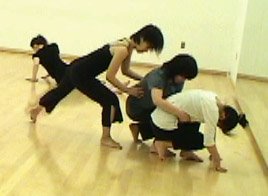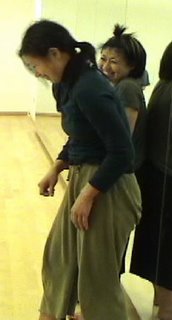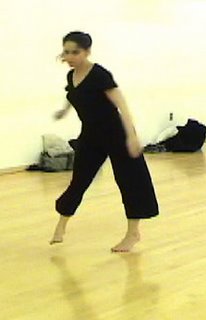Wednesday, April 19, 2006
Concert Announcement: Peripheral Dances

We open in a little over a week!

Peripheral Dances
Featuring works by Gail Accardi, Sue Bernhard, Laurie De Vito, Mami Fujita & Maki Hatae, and Akiko Tomikawa & Rie Hozumi. Dance film by Kristina Jones
Dancers: Gail Accardi, Rachel Feinerman, Mami Fujita, Maki Hatae, Rie Hozumi, Sally Im, Yuko Meads, Hae Young Oh, Megumi Onishi, Nicole Speletic, Akiko Tomikawa, and Alissa Wall
Sundays April 30, May 7, and May 14 at 7:30pm at the
Green Space Studio Theater
37-24 24th Street

Long Island City, NY
Tickets $10
gailaccardi@earthlink.net for reservations and information
More pictures here.

Friday, April 14, 2006
I was born that way
"The DNA of Dancing" THE WEEK, March 10, 2006
Some people, it appears, are born to dance. After analyzing the DNA of the families of 85 professional dancers and 872 other people, researchers spotted two genes that appeared in the dancers, but not in others. They weren't genes for rhythm, coordination, or flexibility. Instead people who love to dance are genetically programmed to respond strongly to hormones and chemicals that promote feelings of spirituality, social communication, and bonding with other people.
"The genes we studied are more related to the emotional side of dancing," researcher Richard Ebstein tells Discovery.com. Dancers, he said, have "the need and ability to communicate with other people and a spiritual side to their natures that not only enable them to feel the music but to communicate that feelings to others via dance."
I was unable to find this particular article online, but did find the Discovery Channel tidbit and--joy to geeks everywhere--the study report. Some highlights and clarifications:
We suggest the notion that the “dance” phenotype is no more difficult to define than other complex human behavioral phenotypes (schizophrenia, attention deficit, personality, violence, and others) that have been shown to be both heritable and amenable to genetic analysis. Dancers fulfill a set of criteria with considerable face validity (similar in principle to the usual Diagnostic and Statistical Manual of Mental Disorders–style “symptom checklist” [12]) that both identifies and distinguishes one disorder from another. For example, the US Department of Labor suggests that the following qualities, inter alia, are required to be a professional dancer: flexibility, agility, coordination, grace, a sense of rhythm, a feeling for music, and a creative ability to express oneself through movement [13].
I of course can't help but be charmed by the grouping of dance with schizophrenia et al and the implication we've a DSM-worthy disorder.
The study looks at two polymorphic genes and notes a preponderance of certain interdependent variations in dancers vs. athletes and also nondancers. These genes have implications correlated with two scales of human personality traits. One is the Tellegen Absorption Scale, which the study cites in reference to its association with spirituality, on the theory that sacred dance rituals have existed across cultures. To me, that sort of aggrandizement seemed unnecessary--the questions reflected, simply, absorption, the ability to lose oneself in the moment. As in that dancer high we all chase, no higher purpose needed. High scores on the scale are also linked to hypnotizability.
The other is the Tridimensional Personality Questionnaire (can't find it online), specifically its Reward Dependence dimension. (Questionnaire description found here):
Tridimensional Personality Questionnaire
The TPQ is a 100-item, self-administered, paper-and-pencil, true/false instrument which takes approximately 15 minutes to complete (Cloninger, 1987a). The questionnaire measures the three higher order personality dimensions of novelty seeking, harm avoidance, and reward dependence, each of which measures four lower order dimensions (Cloninger, 1987b). The novelty seeking domain measures the spectrums of exploratory excitability versus stoic rigidity (9 items), impulsiveness versus reflection (8 items), extravagance versus reserve (7 items), and disorderliness versus regimentation (10 items). The harm avoidance domain measures the spectrums of anticipatory worry versus uninhibited optimism (10 items), fear of uncertainty versus confidence (7 items), shyness with strangers versus gregariousness (7 items), and fatigability and asthenia versus vigor (10 items). The reward dependence domain measures the spectrums of sentimentality versus insensitiveness (5 items), persistence versus irresoluteness (9 items), attachment versus detachment (11 items), and dependence versus independence (5 items). The TPQ is based on a unified biosocial model of personality integrating concepts focused on the neuroanatomical and neurophysiological basis of behavioral tendencies, styles of learning, and the adaptive interaction of the three personality dimensions (Cloninger et al., 1991).
Interestingly, the Village Voice article cited in the previous post mentions
the understanding that choreographers and dance critics have something in common besides a love for the form; we are, as [Tere O'Connor] puts it, "two populations with reward deficit."
Make of that what you will. The dancers scored higher than athletes and nondancers on reward dependence, which the study links with interpersonal communications. On that basis, if we regard dance as a form of communication, it makes some sense, though I'd still like to see the questions to understand where the difference is between competitive (thus, presumably reward-seeking) athletes vs. performing dancers. The study's description of the reward dependent
Individuals high in TPQ Reward Dependence tend to be tender-hearted, loving and warm, sensitive, dedicated, dependent, and sociable [58]. They seek social contact and are open to communication with other people. Typically, they find people they like everywhere they go and are sensitive to social cues, which facilitates warm social relations and understanding of others' feelings. The observed association between TPQ Reward Dependence scores and AVPR1a is consistent with the role of the arginine vasopressin receptor in social communication as demonstrated in extensive animal experiments [59]. The association between AVPR1a and Reward Dependence personality traits strengthens the notion that this gene contributes to dancing through its contribution to social communication.
seems to reflect cultural differences between dance and sport environments, but I've tended to stay away from the more cutthroat competitive end of the dance world. Another gene with connections to the TPQ novelty-seeking dimension showed promise for further study.
My email overstates the story a bit; the genetic differences were not exclusive to the dancers:
The association between AVPR1a and SLC6A4 polymorphisms and creative dancing does not exclude the presence of the same polymorphisms in nondancing groups of subjects. Almost all of us dance and almost all of us have engaged in sports. What the current study suggests is that the combination of polymorphic variants contributing to creative dancing is overrepresented in the dancers. There is no reason to suggest that the nondancer athletes or the control group of nondancers/nonathletes are devoid of these polymorphisms, but the current study provides evidence that these variants are relatively scarce in other groups not specifically selected for the creative dancing phenotype. Importantly, we not only compared creative dancers to performing athletes but also validated the case-control design using a family-based study that avoids the conundrum of a comparison control group that might be “contaminated” with polymorphisms contributing to creative dancing. As for most complex traits, the effect size of these two genes is small and in Risch's terminology will have small displacement [41]
Since one of the genes involves serotonin levels, this study seems to provide a genetic substructure for the previous study showing modern dance relieves anxiety.
I was looking for something else
As O'Connor mentioned in an essay he wrote for Movement Research Journal's fall 2002 issue on criticism, he dislikes it when critics pull what he terms a "stop-action" moment from his work.
This Austin Chronicle article from 2003 may explain why.
Kathy Dunn Hamrick was reading a dance review when a phrase caught her eye: "multiple cuppings of dipped heads." Huh? She had seen the show, too, but the reviewer's description left her baffled. What was a cupping? How many cuppings were there? And did she somehow miss them all? She stood up in her office and began dancing out whatever came to mind -- "funny, bizarre images" -- trying to re-enact the vivid and peculiar phrase. She dipped her head. She cupped her hands. She cupped and dipped again and again.
And then, she got an idea.
This idea was to make an entire program out of phrases from dance reviews. The show would pay tribute to the creativity of dance reviews at the same time that it poked fun at the difficulty of describing modern dance. Its title: "Say What?"
If questions on reading a review include "Did the reviewer see the same dance I did?" or, from the choreographer's POV, "...the dance I choreographed?" Hamrick apparently set out to choreograph the dance the reviewers saw. I can't find video of the piece (nor did I stumble across any reviews) and so have no idea how successful it was.




